Abstract
1. In the isolated perfused rat heart, the contractile activity and the oxygen uptake were varied by altering the aortic perfusion pressure, or by the atrial perfusion technique (`working heart'). 2. The maximum increase in the contractile activity brought about an eightfold increase in the oxygen uptake. The rate of glycolytic flux rose, while tissue contents of hexose monophosphates, citrate, ATP and creatine phosphate decreased, and contents of ADP and AMP rose. 3. The changes in tissue contents of adenine nucleotides during increased heart work were time-dependent. The ATP content fell temporarily (30s and 2min) after the start of left-atrial perfusion; at 5 and 10min values were normal; and at 30 and 60min values were decreased. ADP and AMP values were increased in the first 15min, but were at control values 30 or 60min after the onset of increased heart work. 4. During increased heart work changes in the tissue contents of adenine nucleotide and of citrate appeared to play a role in altered regulation of glycolysis at the level of phosphofructokinase activity. 5. In recirculation experiments increased heart work for 30min was associated with increased entry of [14C]glucose (11.1mm) and glycogen into glycolysis and a comparable increase in formation of products of glycolysis (lactate, pyruvate and 14CO2). There was no major accumulation of intermediates. Glycogen was not a major fuel for respiration. 6. Increased glycolytic flux in Langendorff perfused and working hearts was obtained by the addition of insulin to the perfusion medium. The concomitant increases in the tissue values of hexose phosphates and of citrate contrasted with the decreased values of hexose monophosphates and of citrate during increased glycolytic flux obtained by increased heart work. 7. Decreased glycolytic flux in Langendorff perfused hearts was obtained by using acute alloxan-diabetic and chronic streptozotocin-diabetic rats; in the latter condition there were decreased tissue contents of hexose phosphates and of citrate. There were similar findings when working hearts from streptozotocin-diabetic rats with insulin added to the medium were compared with normal hearts. 8. The effects of insulin addition or of the chronic diabetic state could be explained in terms of an action of insulin on glucose transport. Increased heart work also acted at this site, but in addition there was evidence for altered regulation of glycolysis mediated by changes in tissue contents of adenine nucleotides or of citrate.
Full text
PDF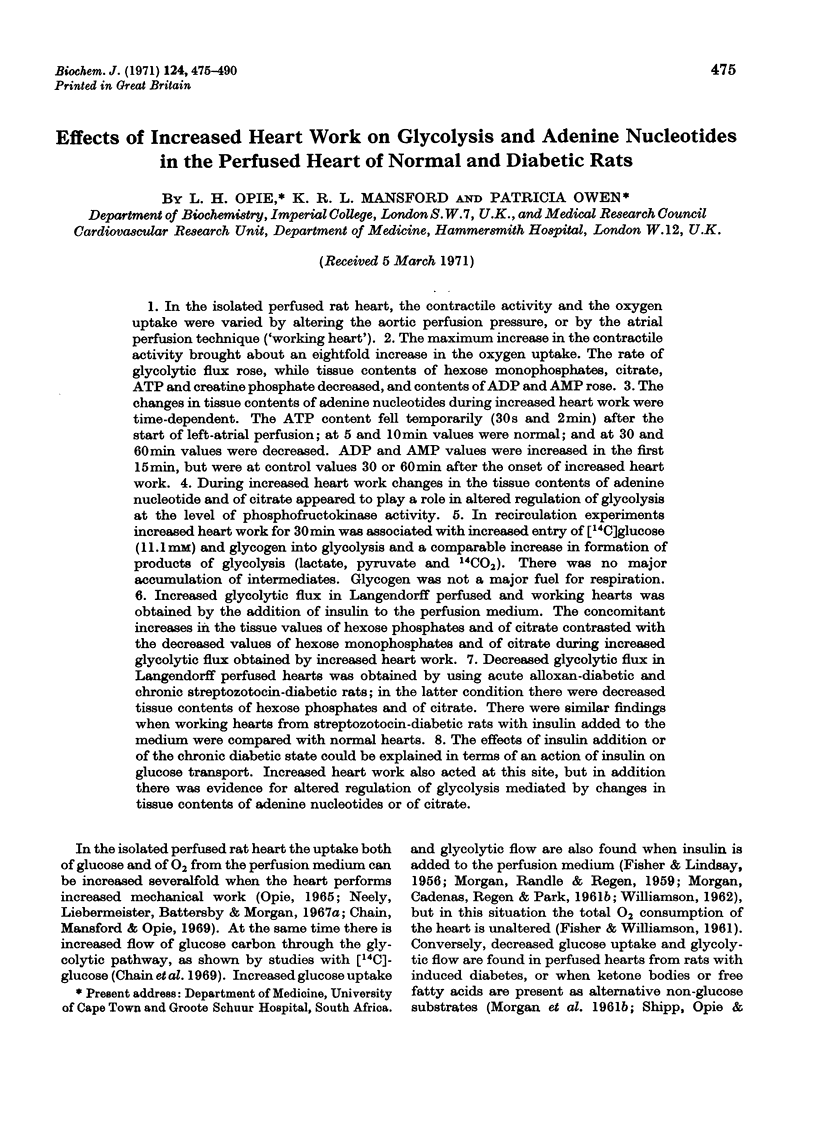
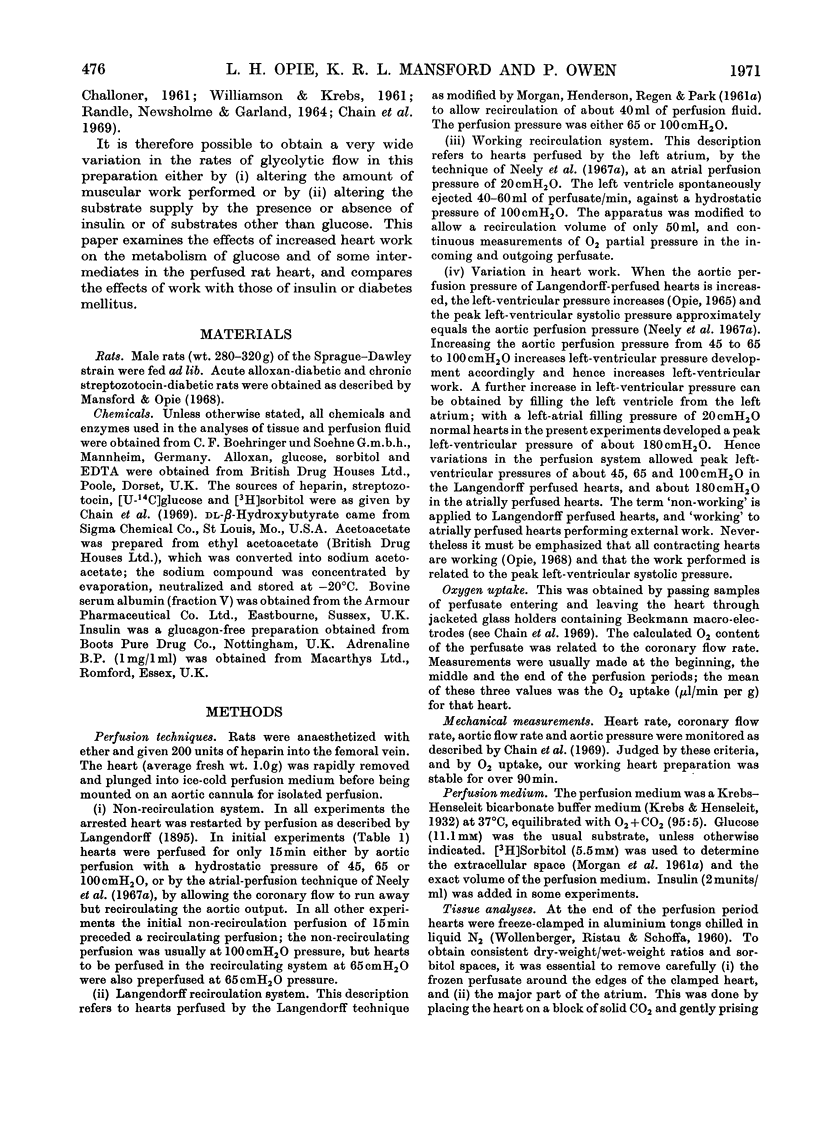
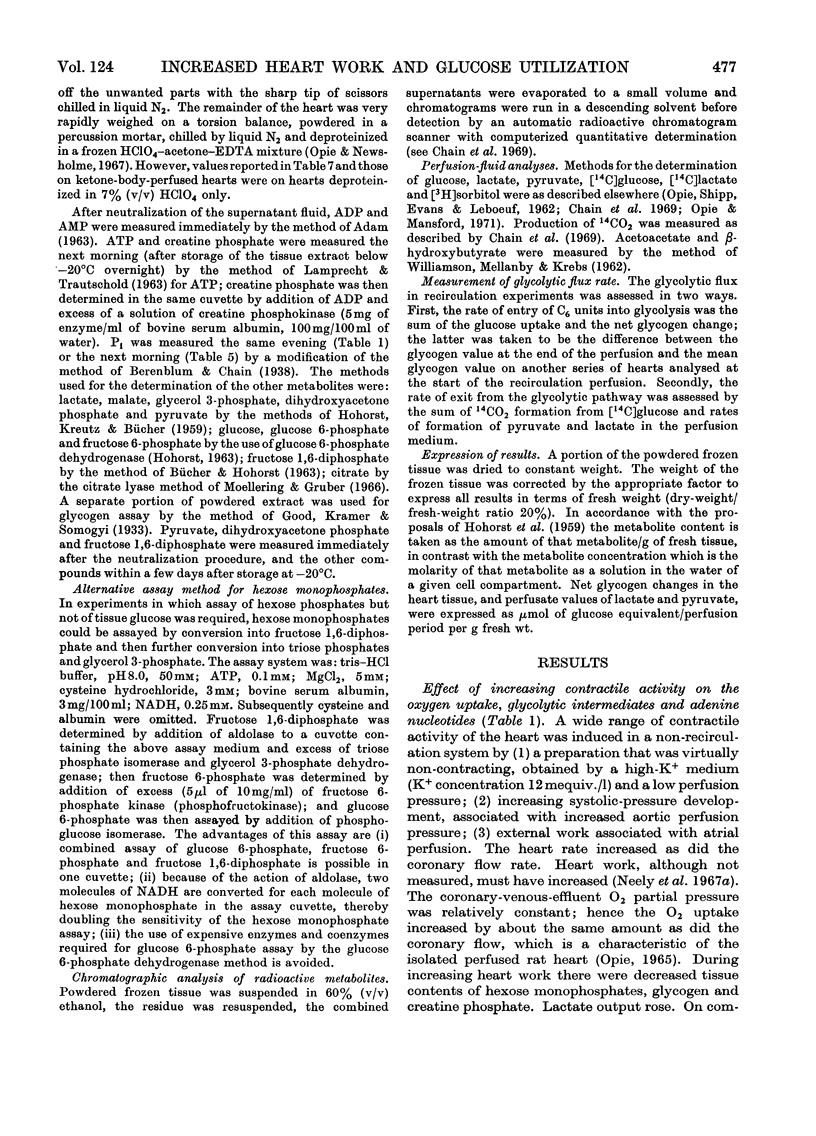
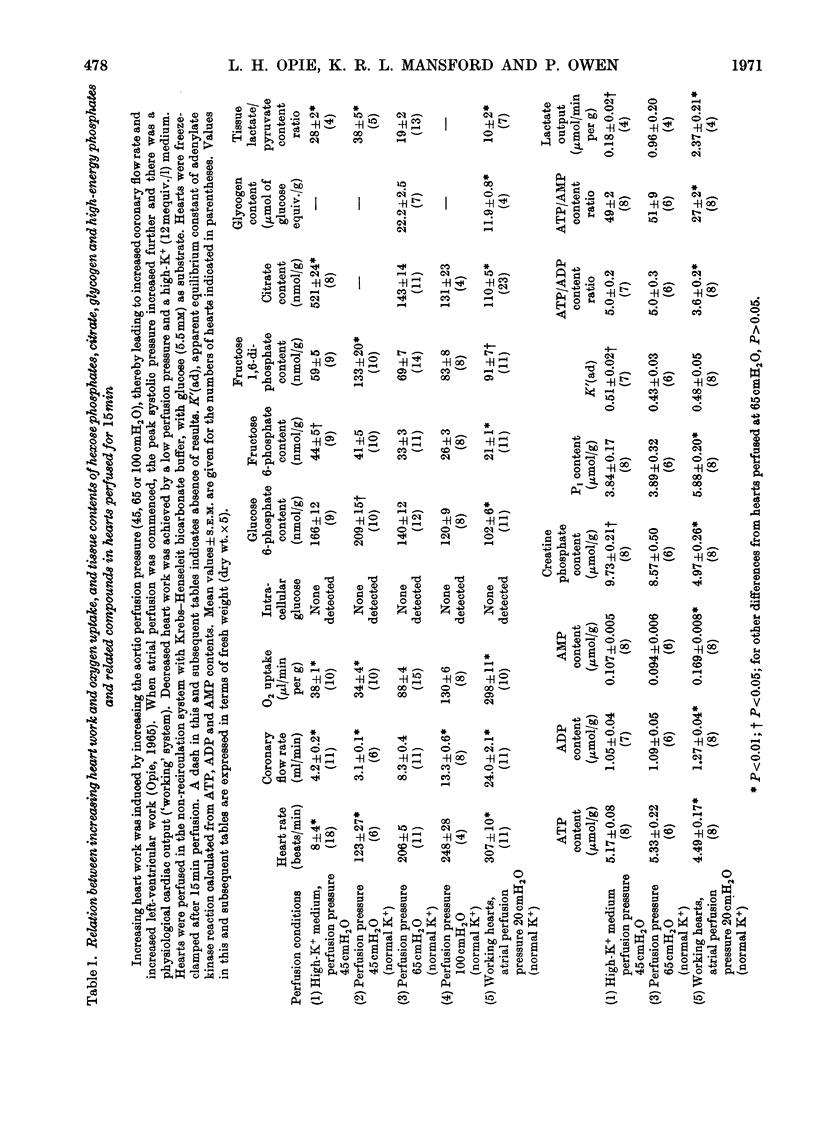
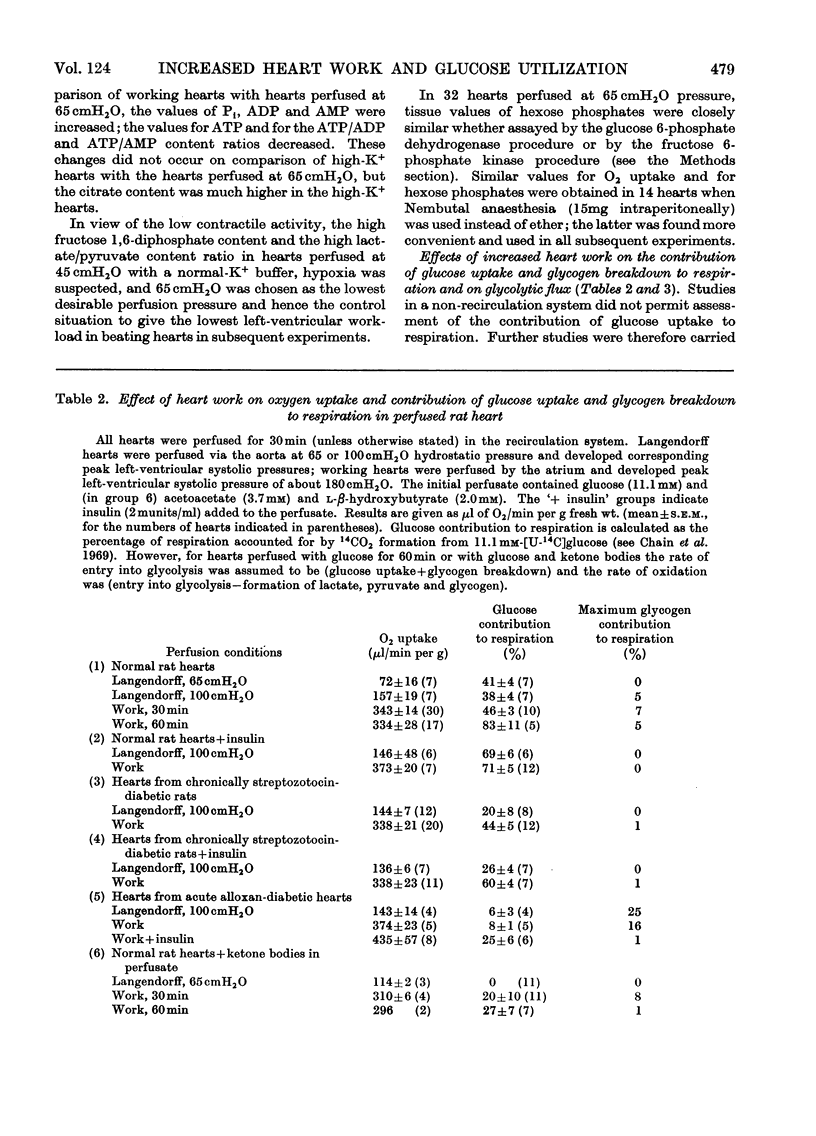
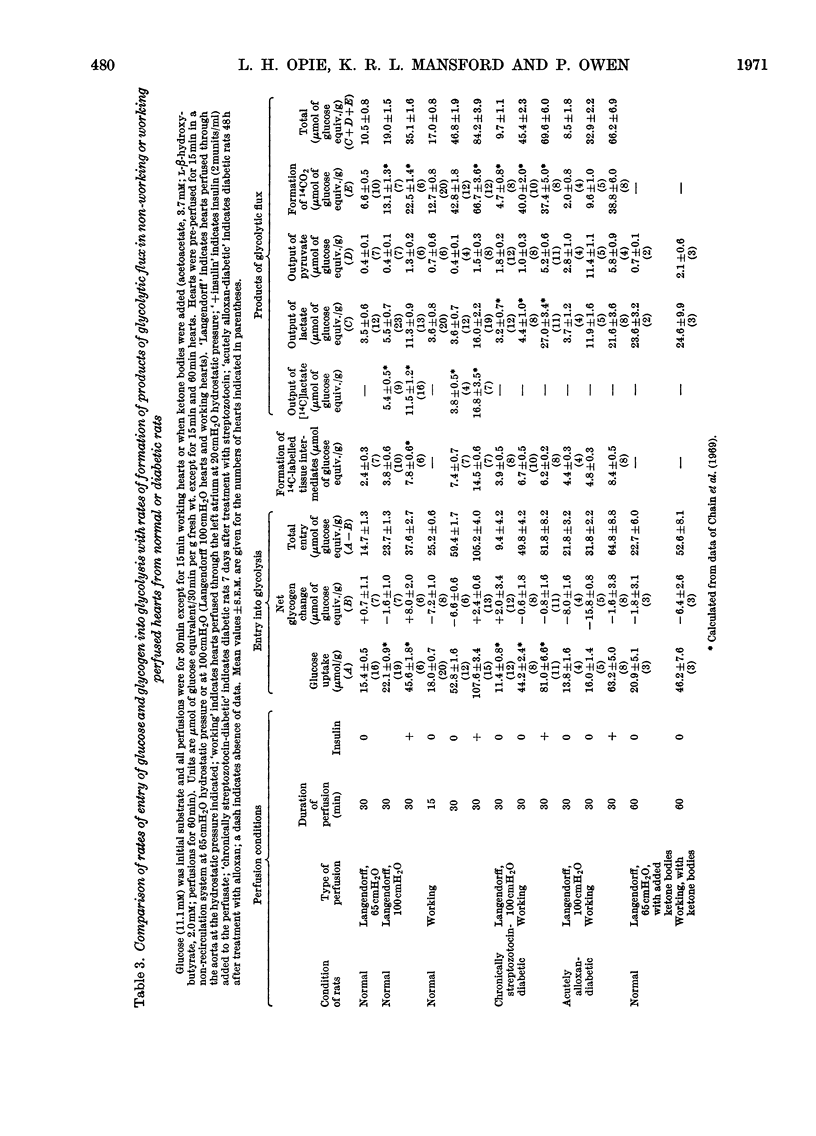
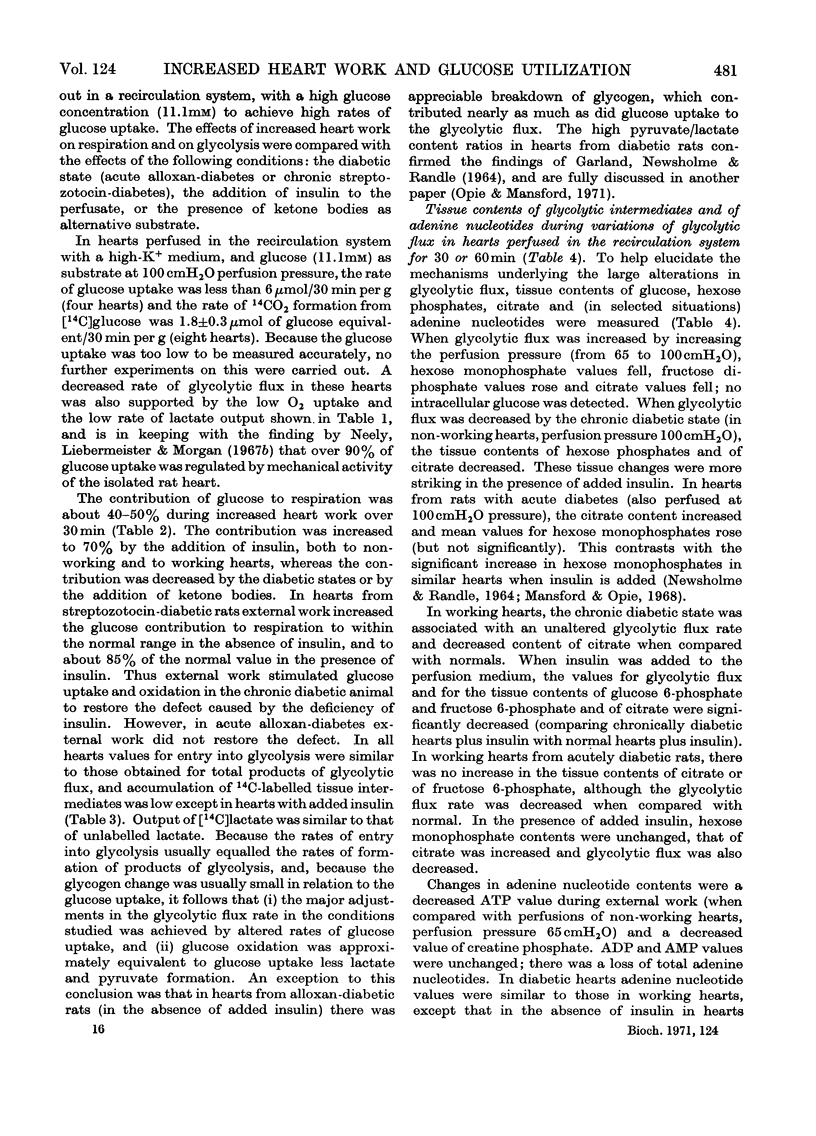
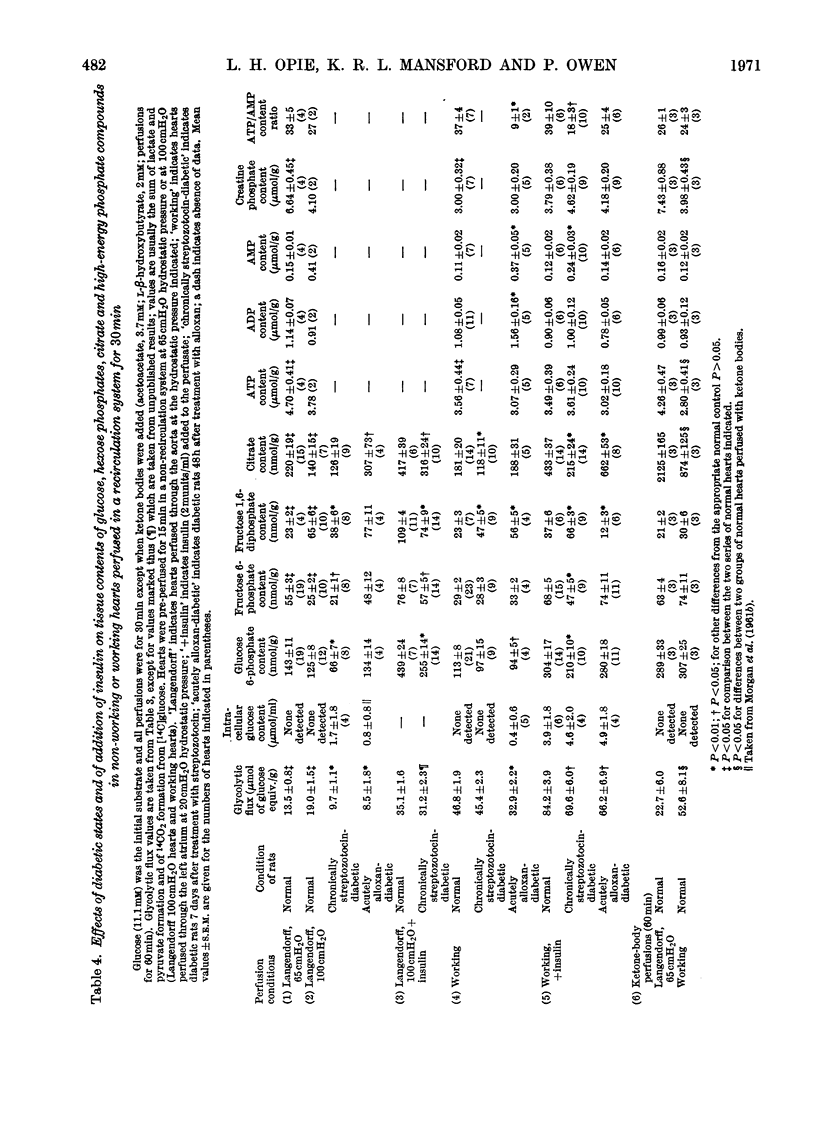
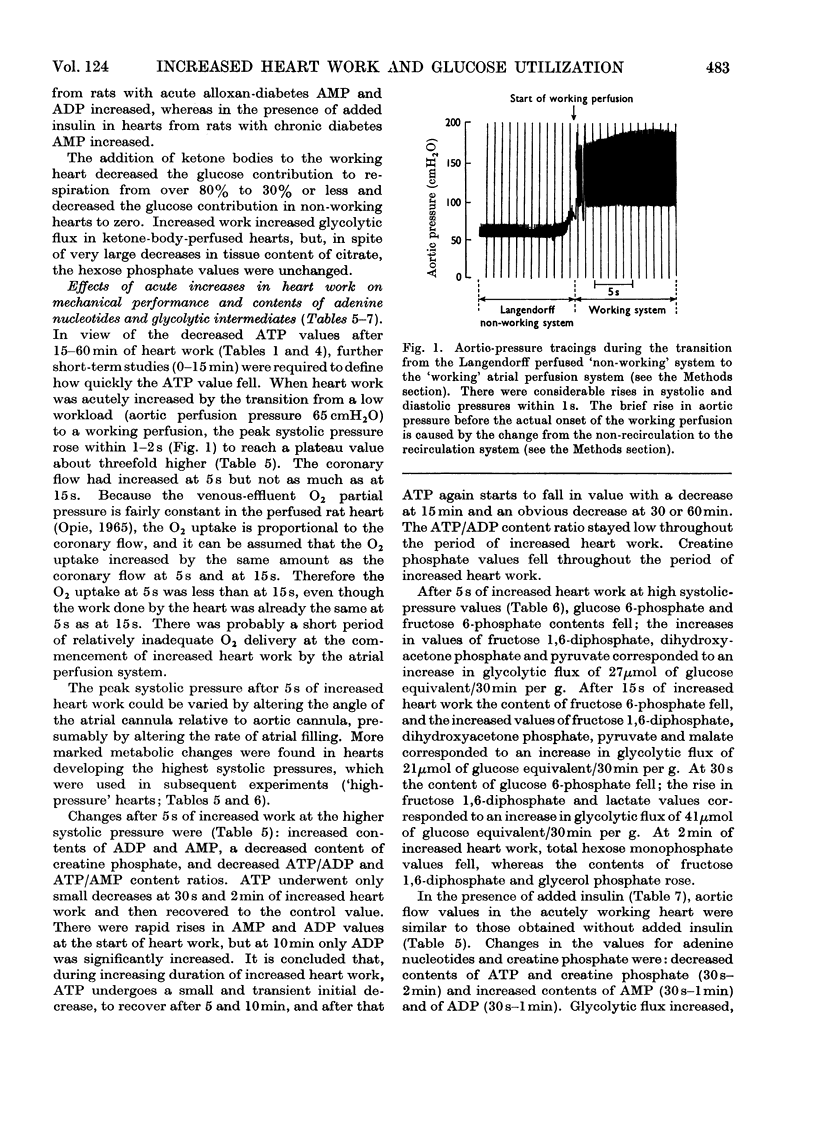
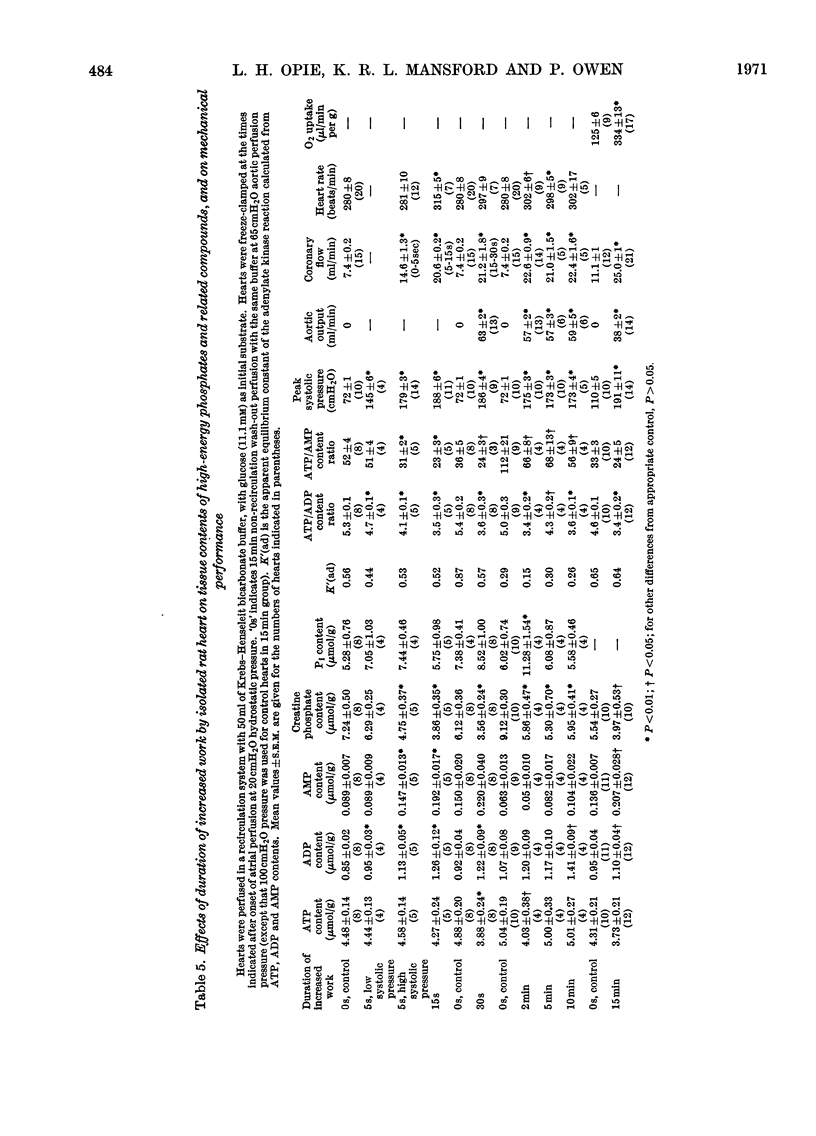
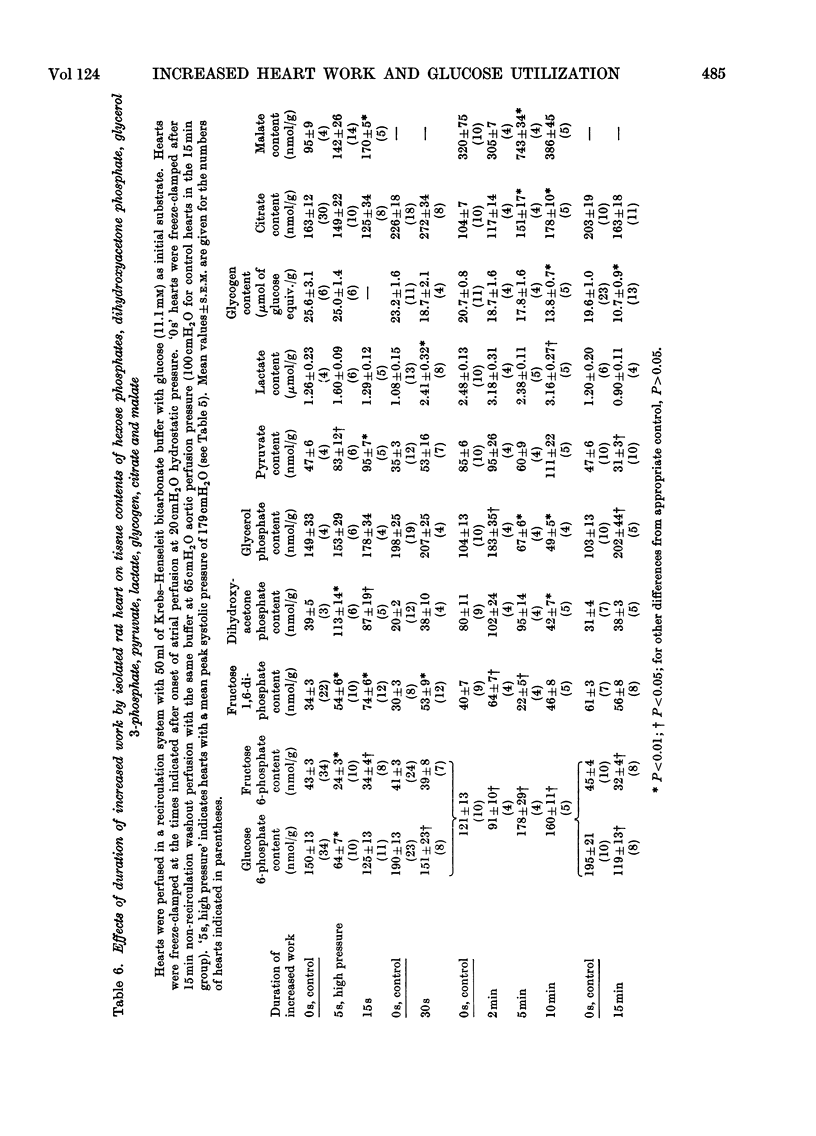
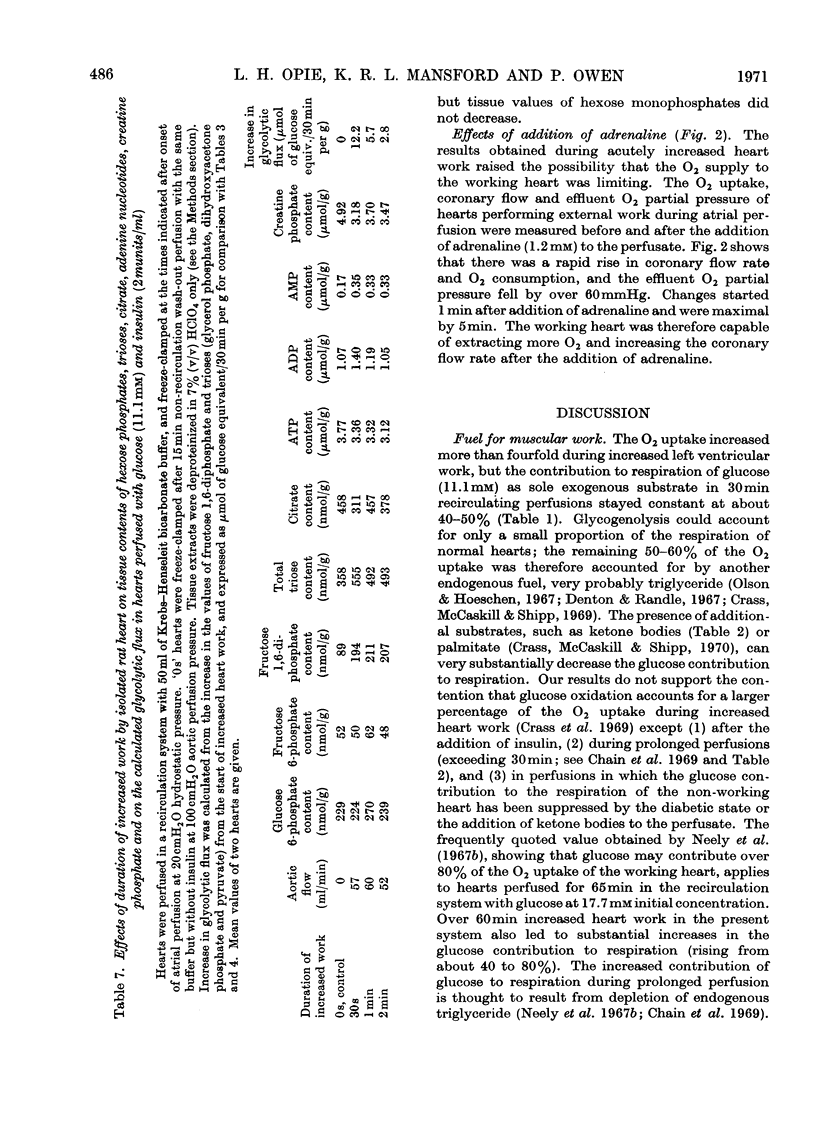
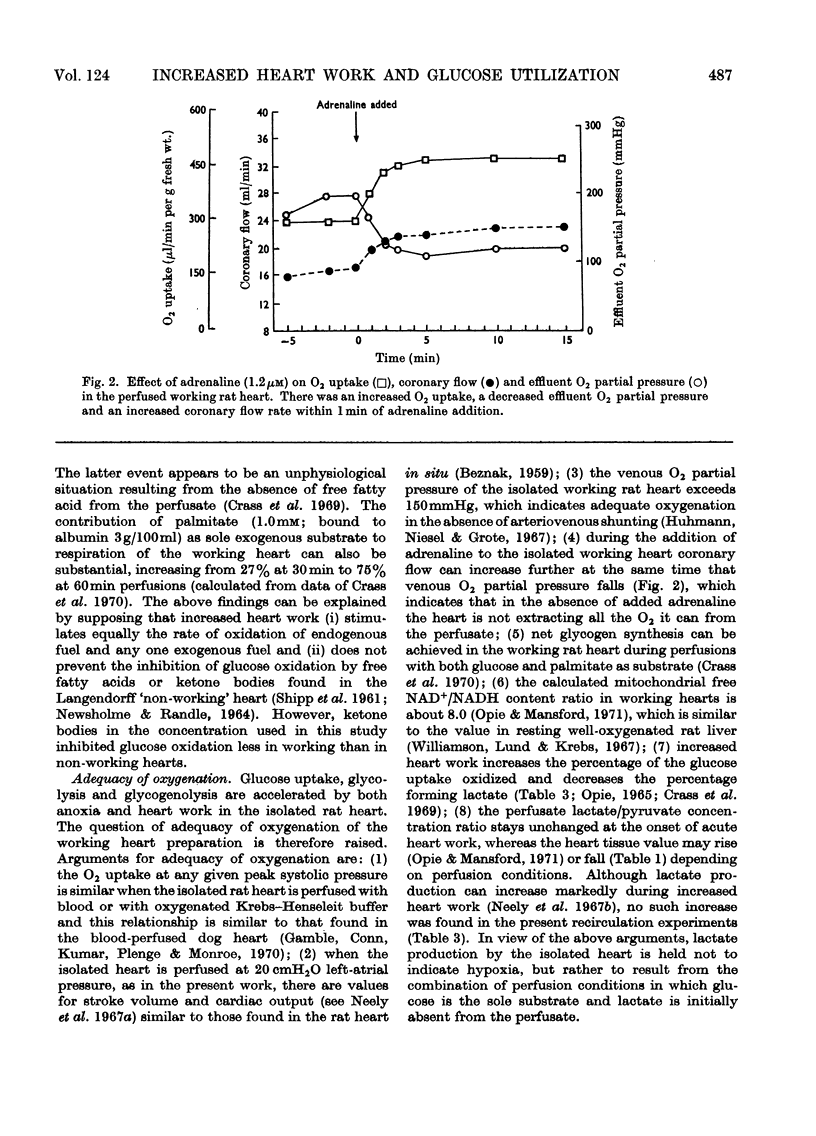
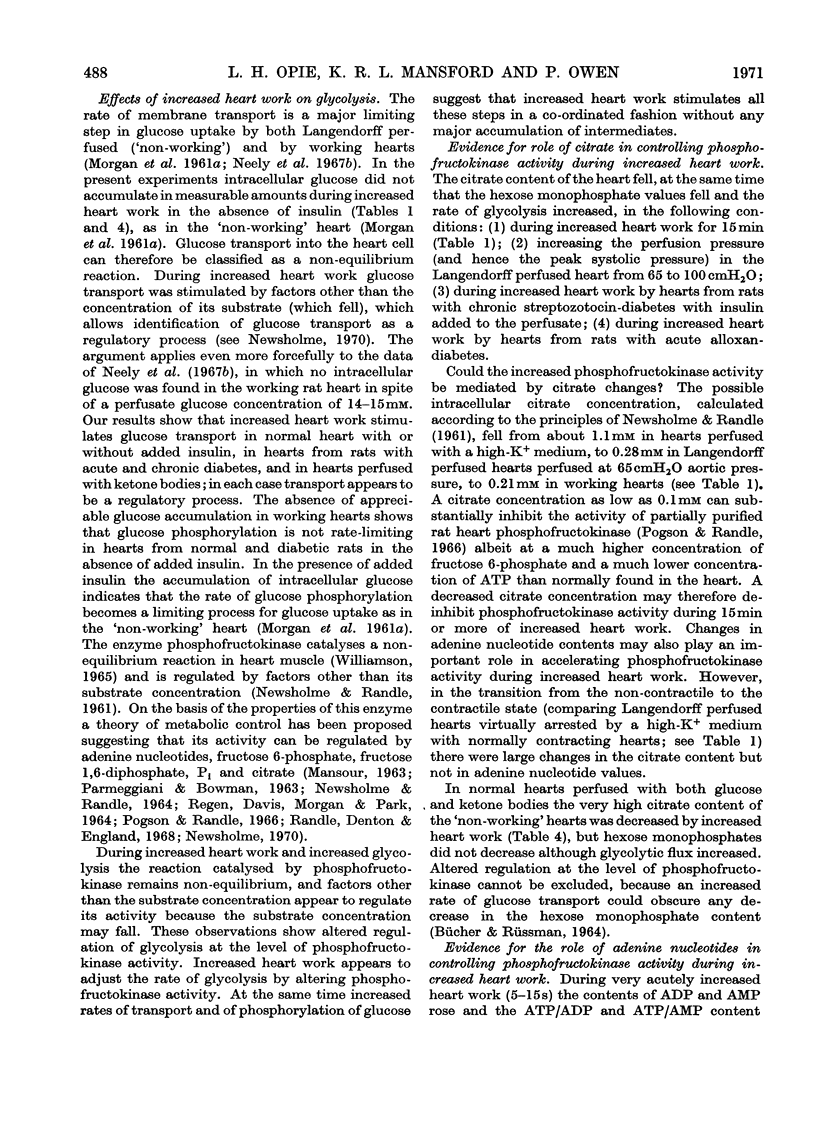
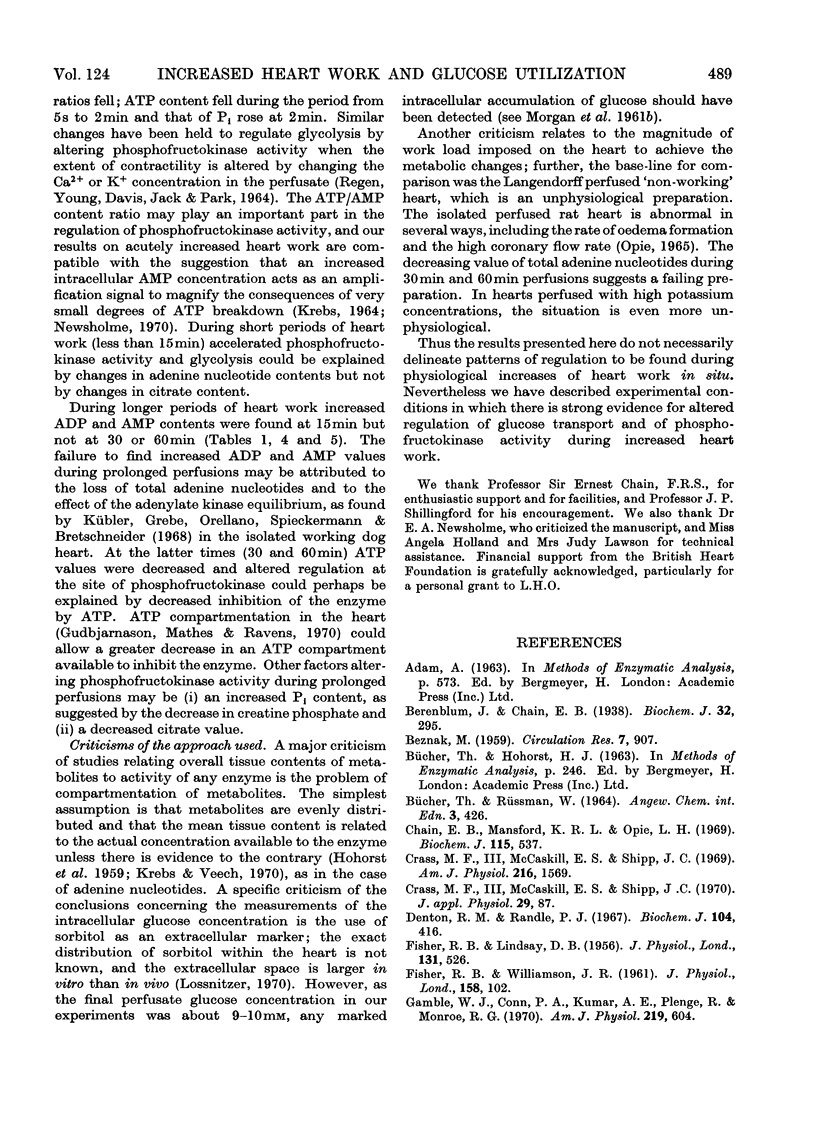
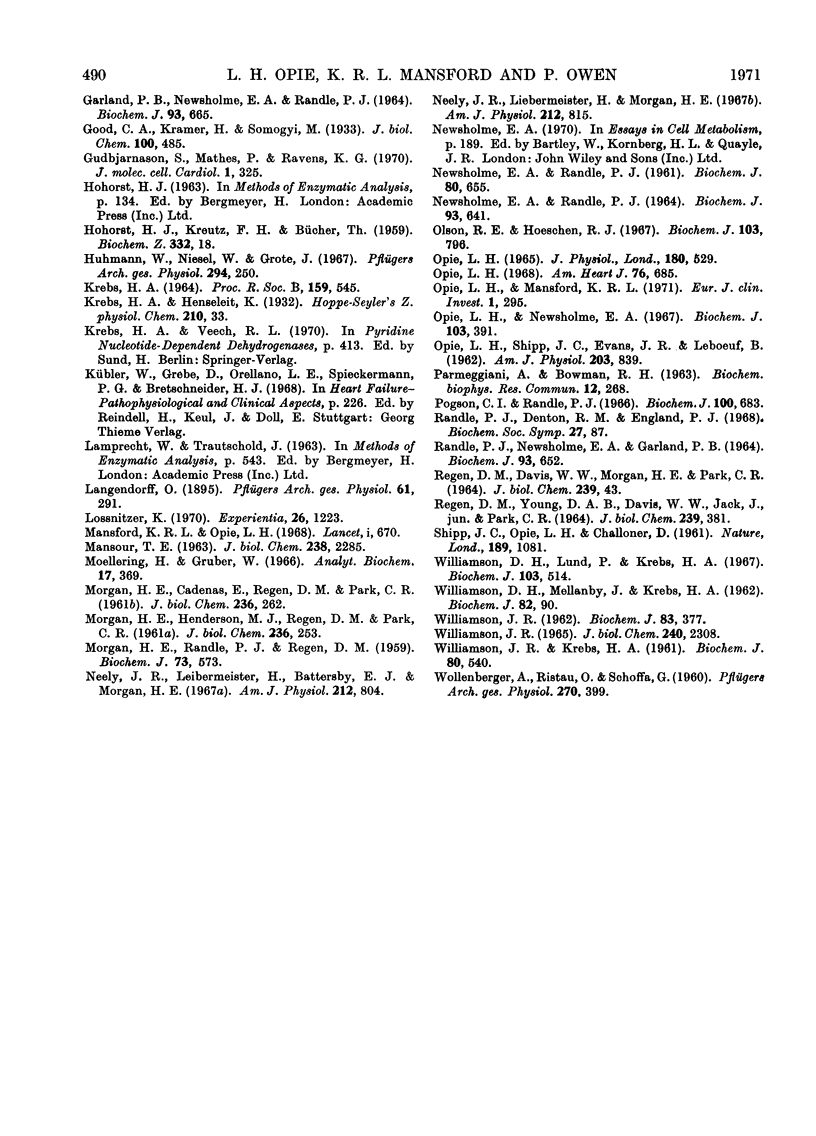
Selected References
These references are in PubMed. This may not be the complete list of references from this article.
- BEZNAK M. Hemodynamic changes in hypophysectomized rats. Circ Res. 1959 Nov;7:907–916. doi: 10.1161/01.res.7.6.907. [DOI] [PubMed] [Google Scholar]
- Berenblum I., Chain E. An improved method for the colorimetric determination of phosphate. Biochem J. 1938 Feb;32(2):295–298. doi: 10.1042/bj0320295. [DOI] [PMC free article] [PubMed] [Google Scholar]
- Chain E. B., Mansford K. R., Opie L. H. Effects of insulin on the pattern of glucose metabolism in the perfused working and Langendorff heart of normal and insulin-deficient rats. Biochem J. 1969 Nov;115(3):537–546. doi: 10.1042/bj1150537. [DOI] [PMC free article] [PubMed] [Google Scholar]
- Crass M. F., 3rd, McCaskill E. S., Shipp J. C. Effect of pressure development on glucose and palmitate metabolism in perfused heart. Am J Physiol. 1969 Jun;216(6):1569–1576. doi: 10.1152/ajplegacy.1969.216.6.1569. [DOI] [PubMed] [Google Scholar]
- Crass M. F., 3rd, McCaskill E. S., Shipp J. C. Glucose-free fatty acid interactions in the working heart. J Appl Physiol. 1970 Jul;29(1):87–91. doi: 10.1152/jappl.1970.29.1.87. [DOI] [PubMed] [Google Scholar]
- Denton R. M., Randle P. J. Concentrations of glycerides and phospholipids in rat heart and gastrocnemius muscles. Effects of alloxan-diabetes and perfusion. Biochem J. 1967 Aug;104(2):416–422. doi: 10.1042/bj1040416. [DOI] [PMC free article] [PubMed] [Google Scholar]
- FISHER R. B., LINDSAY D. B. The action of insulin on the penetration of sugars into the perfused heart. J Physiol. 1956 Mar 28;131(3):526–541. doi: 10.1113/jphysiol.1956.sp005480. [DOI] [PMC free article] [PubMed] [Google Scholar]
- FISHER R. B., WILLIAMSON J. R. The effects of insulin, adrenaline and nutrients on the oxygen uptake of the perfused rat heart. J Physiol. 1961 Sep;158:102–112. doi: 10.1113/jphysiol.1961.sp006757. [DOI] [PMC free article] [PubMed] [Google Scholar]
- Gamble W. J., Conn P. A., Kumar A. E., Plenge R., Monroe R. G. Myocardial oxygen consumption of blood-perfused, isolated, supported, rat heart. Am J Physiol. 1970 Sep;219(3):604–612. doi: 10.1152/ajplegacy.1970.219.3.604. [DOI] [PubMed] [Google Scholar]
- Gudbjarnason S., Mathes P., Ravens K. G. Functional compartmentation of ATP and creatine phosphate in heart muscle. J Mol Cell Cardiol. 1970 Sep;1(3):325–339. doi: 10.1016/0022-2828(70)90009-x. [DOI] [PubMed] [Google Scholar]
- Huhmann W., Niesel W., Grote J. Untersuchungen über die Bedingungen für die Sauerstoffversorgung des Myokards an perfundierten Rattenherzen. I. Zur Frage nach dem Vorliegen einer Gegenstromversorgung. Pflugers Arch Gesamte Physiol Menschen Tiere. 1967;294(4):250–255. [PubMed] [Google Scholar]
- KREBS H. THE CROONIAN LECTURE, 1963. GLUCONEOGENESIS. Proc R Soc Lond B Biol Sci. 1964 Mar 17;159:545–564. doi: 10.1098/rspb.1964.0019. [DOI] [PubMed] [Google Scholar]
- Lossnitzer K. Divergence of the in vitro and in vivo extracellular space measurements in heart muscle. Experientia. 1970 Nov 15;26(11):1223–1224. doi: 10.1007/BF01897978. [DOI] [PubMed] [Google Scholar]
- MORGAN H. E., CADENAS E., REGEN D. M., PARK C. R. Regulation of glucose uptake in muscle. II. Rate-limiting steps and effects of insulin and anoxia in heart muscle from diabetic rats. J Biol Chem. 1961 Feb;236:262–268. [PubMed] [Google Scholar]
- MORGAN H. E., HENDERSON M. J., REGEN D. M., PARK C. R. Regulation of glucose uptake in muscle. I. The effects of insulin and anoxia on glucose transport and phosphorylation in the isolated, perfused heart of normal rats. J Biol Chem. 1961 Feb;236:253–261. [PubMed] [Google Scholar]
- MORGAN H. E., RANDLE P. J., REGEN D. M. Regulation of glucose uptake by muscle. 3. The effects of insulin, anoxia, salicylate and 2:4-dinitrophenol on membrane transport and intracellular phosphorylation of glucose in the isolated rat heart. Biochem J. 1959 Dec;73:573–579. doi: 10.1042/bj0730573. [DOI] [PMC free article] [PubMed] [Google Scholar]
- Mansford K. R., Opie L. Comparison of metabolic abnormalities in diabetes mellitus induced by streptozotocin or by alloxan. Lancet. 1968 Mar 30;1(7544):670–671. doi: 10.1016/s0140-6736(68)92103-x. [DOI] [PubMed] [Google Scholar]
- Moellering H., Gruber W. Determination of citrate with citrate lyase. Anal Biochem. 1966 Dec;17(3):369–376. doi: 10.1016/0003-2697(66)90172-2. [DOI] [PubMed] [Google Scholar]
- NEWSHOLME E. A., RANDLE P. J. Regulation of glucose uptake by muscle. 5. Effects of anoxia, insulin, adrenaline and prolonged starving on concentrations of hexose phosphates in isolated rat diaphragm and perfused isolated rat heart. Biochem J. 1961 Sep;80:655–662. doi: 10.1042/bj0800655. [DOI] [PMC free article] [PubMed] [Google Scholar]
- Neely J. R., Liebermeister H., Battersby E. J., Morgan H. E. Effect of pressure development on oxygen consumption by isolated rat heart. Am J Physiol. 1967 Apr;212(4):804–814. doi: 10.1152/ajplegacy.1967.212.4.804. [DOI] [PubMed] [Google Scholar]
- Neely J. R., Liebermeister H., Morgan H. E. Effect of pressure development on membrane transport of glucose in isolated rat heart. Am J Physiol. 1967 Apr;212(4):815–822. doi: 10.1152/ajplegacy.1967.212.4.815. [DOI] [PubMed] [Google Scholar]
- Newsholme E. A., Randle P. J. Regulation of glucose uptake by muscle. 7. Effects of fatty acids, ketone bodies and pyruvate, and of alloxan-diabetes, starvation, hypophysectomy and adrenalectomy, on the concentrations of hexose phosphates, nucleotides and inorganic phosphate in perfused rat heart. Biochem J. 1964 Dec;93(3):641–651. doi: 10.1042/bj0930641. [DOI] [PMC free article] [PubMed] [Google Scholar]
- OPIE L. H., SHIPP J. C., EVANS J. R., LEBOEUF B. Metabolism of glucose-U-C14 in perfused rat heart. Am J Physiol. 1962 Nov;203:839–843. doi: 10.1152/ajplegacy.1962.203.5.839. [DOI] [PubMed] [Google Scholar]
- Olson R. E., Hoeschen R. J. Utilization of endogenous lipid by the isolated perfused rat heart. Biochem J. 1967 Jun;103(3):796–801. doi: 10.1042/bj1030796. [DOI] [PMC free article] [PubMed] [Google Scholar]
- Opie L. H. Metabolism of the heart in health and disease. I. Am Heart J. 1968 Nov;76(5):685–698. doi: 10.1016/0002-8703(68)90168-3. [DOI] [PubMed] [Google Scholar]
- Opie L. H., Newsholme E. A. The activities of fructose 1,6-diphosphatase, phosphofructokinase and phosphoenolpyruvate carboxykinase in white muscle and red muscle. Biochem J. 1967 May;103(2):391–399. doi: 10.1042/bj1030391. [DOI] [PMC free article] [PubMed] [Google Scholar]
- PARMEGGIANI A., BOWMAN R. H. REGULATION OF PHOSPHOFRUCTOKINASE ACTIVITY BY CITRATE IN NORMAL AND DIABETIC MUSCLE. Biochem Biophys Res Commun. 1963 Aug 1;12:268–273. doi: 10.1016/0006-291x(63)90294-8. [DOI] [PubMed] [Google Scholar]
- Pogson C. I., Randle P. J. The control of rat-heart phosphofructokinase by citrate and other regulators. Biochem J. 1966 Sep;100(3):683–693. doi: 10.1042/bj1000683. [DOI] [PMC free article] [PubMed] [Google Scholar]
- REGEN D. M., DAVIS W. W., MORGAN H. E., PARK C. R. THE REGULATION OF HEXOKINASE AND PHOSPHOFRUCTOKINASE ACTIVITY IN HEART MUSCLE. EFFECTS OF ALLOXAN DIABETES, GROWTH HORMONE, CORTISOL, AND ANOXIA. J Biol Chem. 1964 Jan;239:43–49. [PubMed] [Google Scholar]
- REGEN D. M., YOUNG D. A., DAVIS W. W., JACK J., Jr, PARK C. R. ADJUSTMENT OF GLYCOLYSIS TO ENERGY UTILIZATION IN THE PERFUSED RAT HEART. THE EFFECT OF CHANGES IN THE IONIC COMPOSITION OF THE MEDIUM ON PHOSPHOFRUCTOKINASE ACTIVITY. J Biol Chem. 1964 Feb;239:381–384. [PubMed] [Google Scholar]
- Randle P. J., Denton R. M., England P. J. Citrate as a metabolic regulator in muscle and adipose tissue. Biochem Soc Symp. 1968;27:87–103. [PubMed] [Google Scholar]
- Randle P. J., Newsholme E. A., Garland P. B. Regulation of glucose uptake by muscle. 8. Effects of fatty acids, ketone bodies and pyruvate, and of alloxan-diabetes and starvation, on the uptake and metabolic fate of glucose in rat heart and diaphragm muscles. Biochem J. 1964 Dec;93(3):652–665. doi: 10.1042/bj0930652. [DOI] [PMC free article] [PubMed] [Google Scholar]
- Randle P. J., Newsholme E. A., Garland P. B. Regulation of glucose uptake by muscle. 8. Effects of fatty acids, ketone bodies and pyruvate, and of alloxan-diabetes and starvation, on the uptake and metabolic fate of glucose in rat heart and diaphragm muscles. Biochem J. 1964 Dec;93(3):652–665. doi: 10.1042/bj0930652. [DOI] [PMC free article] [PubMed] [Google Scholar]
- WILLIAMSON D. H., MELLANBY J., KREBS H. A. Enzymic determination of D(-)-beta-hydroxybutyric acid and acetoacetic acid in blood. Biochem J. 1962 Jan;82:90–96. doi: 10.1042/bj0820090. [DOI] [PMC free article] [PubMed] [Google Scholar]
- WILLIAMSON J. R. Effects of insulin and diet on the metabolism of L-lactate and glucose by the perfused rat heart. Biochem J. 1962 May;83:377–383. doi: 10.1042/bj0830377. [DOI] [PMC free article] [PubMed] [Google Scholar]
- WILLIAMSON J. R. GLYCOLYTIC CONTROL MECHANISMS. I. INHIBITION OF GLYCOLYSIS BY ACETATE AND PYRUVATE IN THE ISOLATED, PERFUSED RAT HEART. J Biol Chem. 1965 Jun;240:2308–2321. [PubMed] [Google Scholar]
- WILLIAMSON J. R., KREBS H. A. Acetoacetate as fuel of respiration in the perfused rat heart. Biochem J. 1961 Sep;80:540–547. doi: 10.1042/bj0800540. [DOI] [PMC free article] [PubMed] [Google Scholar]
- WOLLENBERGER A., RISTAU O., SCHOFFA G. [A simple technic for extremely rapid freezing of large pieces of tissue]. Pflugers Arch Gesamte Physiol Menschen Tiere. 1960;270:399–412. [PubMed] [Google Scholar]
- Williamson D. H., Lund P., Krebs H. A. The redox state of free nicotinamide-adenine dinucleotide in the cytoplasm and mitochondria of rat liver. Biochem J. 1967 May;103(2):514–527. doi: 10.1042/bj1030514. [DOI] [PMC free article] [PubMed] [Google Scholar]


